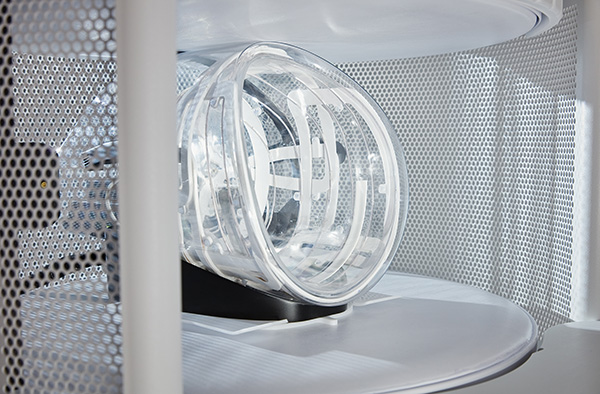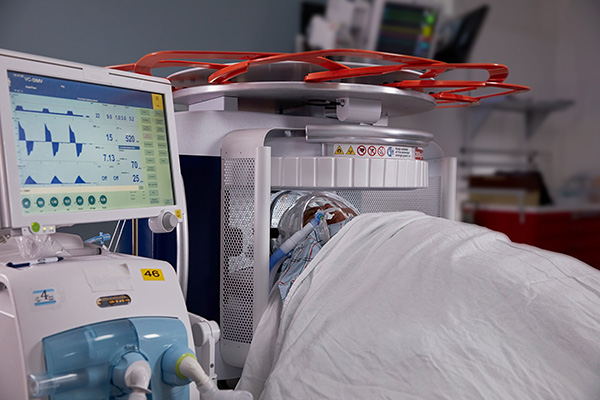Swoop® Portable MR Imaging System™
Frequently asked questions.
Pricing
What is the price of the Swoop Portable MR Imaging System?
For pricing information, please click here to contact a Hyperfine sales associate. Hyperfine offers the Swoop system with a multi-year subscription, which includes product support, software updates and image quality improvements, and customer success.
Operation

What training is required to operate a Swoop system, and how many people should be trained?
Hyperfine offers in-person and virtual training to teach operators at your facility how to drive a Swoop system and operate it with the provided iPad®. The number of people trained to operate the Swoop Portable MR Imaging System will depend on your facility guidelines and workflow. Our goal is to support facility-specific needs and create a program that sets you up for success.
Does the Swoop system require a dedicated room for running scans?
A dedicated room is not required—the Swoop system maneuvers through hospital environments and wheels directly to a patient’s bedside. The system contains a unique proprietary radiofrequency noise cancellation system that enables it to create images in typical hospital environments, where conventional MRI systems cannot.
Does the Swoop system require a dedicated room for storage?
The Swoop system does not require a dedicated storage room. We provide stanchions to indicate a controlled access area. Ideally, you’ll want to store the Swoop system in a location with an electrical outlet for charging.
How long does it take for the Swoop system to be ready to scan?
The Swoop system is ready to image less than three minutes after plugging into power when stored under the specified environmental humidity and temperature conditions.
Is the imaging integrated into the hospital radiology picture archiving and communication system (PACS)?
The Swoop system sends standard digital imaging and communications in medicine (DICOM) enhanced data to local PACS or Hyperfine Cloud PACS. Additionally, the system can pull the modality worklist.
Usage
Is brain imaging the only application for the Swoop system?
The Swoop Portable MR imaging System is US FDA (Food and Drug Administration) cleared as a bedside magnetic resonance imaging device for producing images that display the internal structure of the head where full a diagnostic examination is not clinically practical. When interpreted by a trained physician, these images provide information that can be useful in determining a diagnosis. Our product roadmap includes potential expansions of indications and settings.
What are the use cases for the Swoop system?
Clinicians have found the Swoop system helpful with imaging in the following areas:
- Serial imaging in intensive care unit settings
- Assessing acute mental status change
- Pre- and Post-op assessment
- Brain trauma follow up
- Point-of-care MRI in stroke workflow
- Assessing DWI/FLAIR mismatch
- Immediate assessment post endovascular procedures
- Pediatric and adult neuroimaging
- Hydrocephalus assessment
- Follow up evaluation of head injury
- Assessment and follow up of acute mental status change
- Intraparenchymal hemorrhage or hematoma
The Swoop system has the potential to be used for additional clinical use cases where conventional MR imaging is exceedingly difficult or not feasible.

What imaging sequences does the Swoop system include?
Imaging sequences include T1, T2, FLAIR, and DWI (with accompanying ADC map).
Does the Swoop system replace fixed conventional MRI systems?
The Swoop Portable MR Imaging System is not a replacement for fixed conventional MRI systems. Instead, it is a specialized tool used to answer specific clinical questions when obtaining those answers using conventional MRI is not desirable, not possible, or too dangerous for the patient. The Swoop system is capable of non-contrast-enhanced brain imaging.
Does the Swoop system use temperature control?
The operating temperature range of the Swoop system is 15 to 30 degrees Celsius (59 to 86 degrees Fahrenheit). Unlike fixed conventional MRI systems that use superconducting magnets, the Swoop system’s permanent magnet design does not require liquid helium or other cryogens.
What additional shielding is needed for magnetic fields or radiofrequency (RF) interference? Is it the same as a fixed conventional MRI system?
Unlike a fixed conventional MRI system, the Swoop system requires no additional shielding for magnetic fields or RF interference because of the low static magnetic field and built-in passive RF shielding and active RF noise cancellation technology used in the Swoop system.
In what imaging planes can the scans be obtained?
The Swoop system can acquire in all three orthogonal planes—axial, sagittal, and coronal. All of the 3D sequences can be acquired in the axial plane. In addition, the T1-weighted, T2-weighted, and FLAIR pulse sequences are available in any orthogonal plane. The Swoop system automatically aligns the imaging orientation to the patient’s orientation using a one-minute scout or localizer scan.

Can a Swoop system scan patients on ventilators?
The Swoop system is not contraindicated for patients on ventilators, but it is important to remember to keep the ventilator positioned beyond the 5 gauss area.
Is there any risk for radiofrequency burns?
The Swoop system’s specific absorption rate (SAR) limitations are well below any safety concerns for the intended patient population with respect to its intended use, MRI of the brain. For example, the head SAR value never exceeds a value of 0.009-W/kg for any pulse sequence.
How much acoustic noise does the Swoop system make?
The audible noise of the Swoop system is significantly lower than what is encountered in a fixed conventional MRI system, making it comfortable for all patients, including pediatrics. The peak noise level inside the Swoop system is approximately 85 decibels, which is about the same level as the sound of city traffic heard while inside a car or chamber music in a small auditorium. Acoustic noise levels associated with the Swoop system are substantially lower than the limits recommended by the IEC 60601-2-33 standard. Therefore, no hearing protection is required but may be preferred by some patients.
Billing
What billing code is used with the Swoop system?
The Swoop Portable MR Imaging System is indicated as a “Point-of-Care Magnetic Resonance Imaging Device for producing images that display the internal structure of the head where a full diagnostic examination is not clinically practical. When interpreted by a trained physician, these images provide information that can be useful in determining a diagnosis.”
Billing codes for using the Swoop system are the same as those used for any MR imaging of the brain:
- Code: CPT 70551. If a radiology report is generated, then you can obtain global reimbursement.
- Description: Magnetic resonance (e.g., proton) imaging, brain (including brain stem); without contrast material
Does Medicare cover Swoop exams?
Medicare approves specific MRI procedures, not vendor-specific MRI systems. Scans with the Swoop system are reimbursable using CPT 70551 (brain imaging without contrast materials).